
Stangeria eriopus is a cycad endemic to southern Africa. It is the sole species in the genus Stangeria, most closely related to the Australian genus Bowenia, with which it forms the family Stangeriaceae.

Encephalartos is a genus of cycad native to Africa. Several species of Encephalartos are commonly referred to as bread trees, bread palms or kaffir bread, since a bread-like starchy food can be prepared from the centre of the stem. The genus name is derived from the Greek words en (within), kephalē (head), and artos (bread), referring to the use of the pith to make food. They are, in evolutionary terms, some of the most primitive living gymnosperms.

Encephalartos woodii, Wood's cycad, is a rare cycad in the genus Encephalartos, and is endemic to the oNgoye Forest of KwaZulu-Natal, South Africa. It is one of the rarest plants in the world, being extinct in the wild with all specimens being clones of the type. The specific and common name both honour John Medley Wood, curator of the Durban Botanic Garden and director of the Natal Government Herbarium of South Africa, who discovered the plant in 1895.
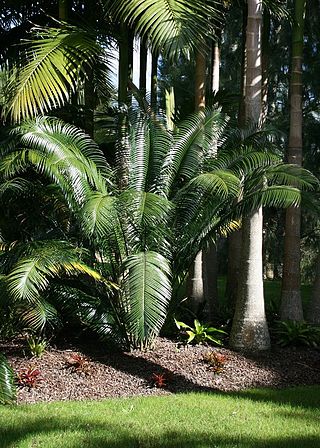
Lepidozamia peroffskyana is a palm-like cycad in the family Zamiaceae. It is endemic to eastern Australia. The species is named after Count Peroffsky (1794-1857), benefactor of the St. Petersburg Botanical Garden.

Modjadji Nature Reserve, also known as the Modjadji Cycad Reserve, is situated near Modjadjiskloof, Limpopo province, South Africa. The reserve has an area of around 350 hectares. It encloses two steep ridges that are densely forested with the cycad Encephalartos transvenosus, the population of which is estimated at 15,000 individuals.

Encephalartos altensteinii is a palm-like cycad in the family Zamiaceae. It is endemic to South Africa. The species name altensteinii commemorates Altenstein, a 19th-century German chancellor and patron of science. It is commonly known as the breadtree, broodboom, Eastern Cape giant cycad or uJobane (Zulu). It is listed as vulnerable due to habitat destruction, use for traditional medicine and removal by collectors.
Encephalartos brevifoliolatus, the escarpment cycad, is a cycad in the African genus Encephalartos. It is extinct in the wild. The escarpment cycad was found in short grasslands in the very open Protea savanna on the northern Drakensberg escarpment in South Africa's Limpopo Province. These plants are used to growing on large cliffs.
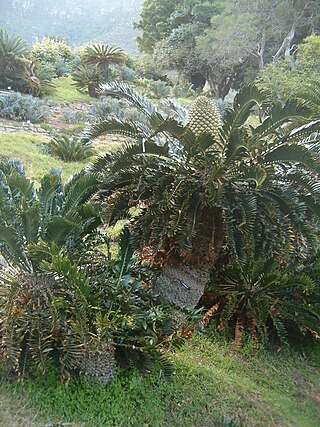
Encephalartos latifrons is a species of cycad that is native to Eastern Cape province in South Africa at elevations of 200 and 600 metres.

Encephalartos natalensis, the Natal cycad or giant cycad, is a species of cycad that is endemic to the Qumbu and Tabankulu areas of the northern part of the Eastern Cape, and through most of KwaZulu-Natal. The number of mature individuals of this species is declining and the International Union for Conservation of Nature has assessed its conservation status as being "near threatened".

Encephalartos friderici-guilielmi is a species of cycad that is native to Eastern Cape province and KwaZulu-Natal province of South Africa at elevations of 700 up to 1400 meters.

Encephalartos eugene-maraisii is a species of cycad in the family Zamiaceae. It is endemic to South Africa, where it is limited to Limpopo. It is known as the Waterberg cycad.

Encephalartos dolomiticus, the Wolkberg cycad, is a critically endangered species of cycad. It is only found in the Wolkberg at elevations of 1100–1500 meters. The area is near Penge in southeastern Limpopo Province, South Africa.
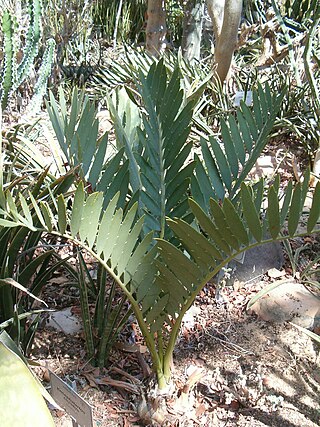
Encephalartos cupidus is a species of cycad that is found in the Limpopo Province, South Africa at elevations of 700 up to 1,500.
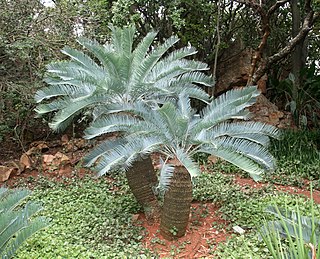
Encephalartos laevifolius is a species of cycad that is found in the KwaZulu-Natal, Mpumalanga and Limpopo provinces of South Africa, and at Piggs Peak in Eswatini. The species is facing extinction in the wild, but is widely cultivated. As of 2012, the Encephalartos laevifolius has been listed as critically endangered by the IUCN.
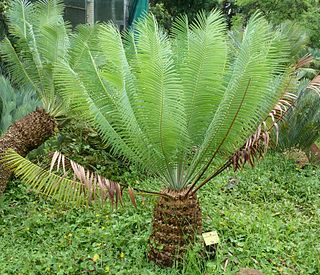
Encephalartos inopinus is a species of cycad that is native to Limpopo Province, South Africa.

Encephalartos septentrionalis, the Nile cycad, is a species of cycad in South Sudan, northern Uganda, northern Democratic Republic of the Congo, and the interior of the Central African Republic.
Encephalartos dyerianus, known colloquially as the Lillie cycad, is a species of cycad that is native to hillsides in the lowveld of eastern Limpopo, South Africa.

Encephalartos lanatus is a species of cycad, a plant belonging to the family Zamiaceae growing in Mpumalanga, South Africa. Its specific epithet, lanatus, means wooly in Latin.

Encephalartos nubimontanus is a species of cycad which is native to Limpopo, South Africa.

Encephalartos tegulaneus, the Kenyan giant cycad, is a species of cycad endemic to Kenya. It occurs in Eastern Province near Embu, Kenya, and on the Matthews Range in Rift Valley Province.



















